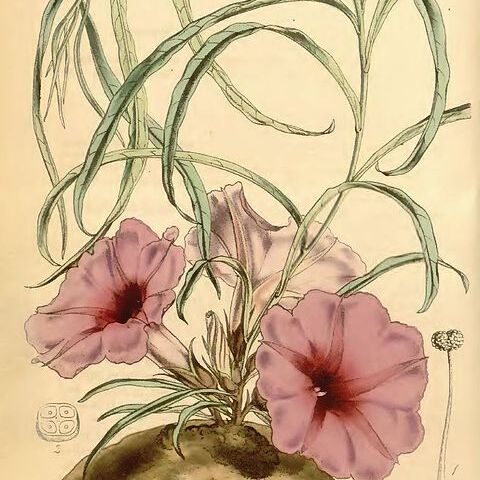Glabrous perennial with tuberous rootstock, 40-100 mm long. Stems erect, woody, up to 90 mm underground, above ground up to 100 mm long. Leaves dense, linear to lanceolate, 30-100 mm long, subsessile, mostly entire. Flowers solitary, axillary; peduncles and pedicels short; bracteoles linear. Sepals subequal, lanceolate, 9-15 mm long. Corolla funnel-shaped, white, 20-35 mm long. Flowering time Sept.-Apr. Fruit a subglobose, glabrous capsule, 7-9 mm wide. Seeds 4-5 mm long, dark brown, tomentose.
An erect, smooth herb. It keeps growing from year to year from a tuberous rootstock. The stems are woody. The leaves are simple and alternate. The leaves are narrow to sword shaped. The flowers occur singly in the axils of leaves. They are trumpet shaped and white and 20-35 mm long. They have shallow lobes. The fruit is a round or oval capsule. The seeds are dark brown and slightly hairy.
Perennial herb, up to 100 mm high. Stems erect. Leaves subsessile; blade linear to narrowly ovate, 30-100 mm long, apex long-tapering, margin entire or with a few teeth or lobes. Flowers: solitary, axillary; calyx lobes narrowly ovate to narrowly ovate-oblong, acute; corolla 20-35 mm long, white; Oct.-Dec. Fruit a subglobose, glabrous capsule, 7-9 mm in diameter; seeds tomentose.
Erect perennial herb, up to 100 mm tall. Leaves linear to lanceolate, entire or with few pinnately arranged teeth or lobes, acuminate or acute at apex; long-tapering and almost sessile or sometimes rounded with distinct petiole. Sepals lanceolate or oblong-lanceolate to ovate-lanceolate, acute. Corolla 20-35 mm long. Flowers white.

